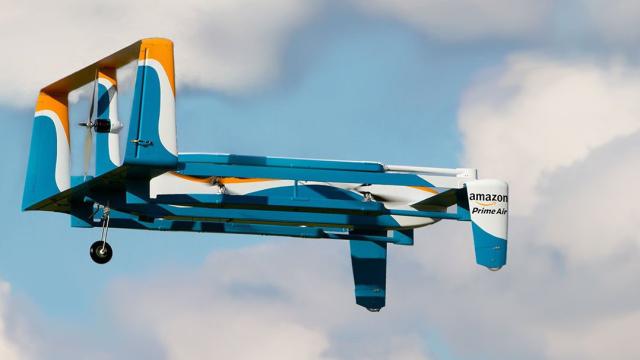Amazon’s delivery drone service has been under development for some time. Now, in a big interview with Yahoo Tech, its vice president for global public policy, Paul Misener, has explained in more detail than ever how the scheme will work.
While he did admit that the company hadn’t “priced out” how much drone deliveries will cost when they first launch, he did have a lot to say about the drones themselves. Speaking about the service will work in reality, Misener explained:
Prime Air is a future delivery service that will get packages to customers within 30 minutes of them ordering it online at Amazon.com. The goals we’ve set for ourselves are: The range has to be over 10 miles [16km]. These things will weigh about 55 pounds each [25kg], but they’ll be able to deliver parcels that weigh up to five pounds [2kg]. It turns out that the vast majority of the things we sell at Amazon weigh less than five pounds.
But despite the payloads being predictable across the majority of US customers, flying conditions certainly won’t be. That’s why, Misener pointed out, Amazon is actually readying a variety of different drones that will be suited to different conditions throughout America:
Our customers in the United States live in hot, dry, dusty areas like Phoenix, but they also live in hot, wet, rainy environments like Orlando, or up in the Colorado Rockies. Likewise, obviously, our customers live in a wide variety of buildings. Some live in rural farmhouses, some live in high-rise city skyscrapers, and then everything in between, in suburban and exurban environments. We want to be able to serve all of those customers. And it may take a different kind of a drone to best work in each one.
And those drones won’t just be tailored for efficient flying. Likening the aircraft to animals, Amazon’s vice president explained that they will be equipped with advanced “sense-and-avoid” technology:
These drones are more like horses than cars — and let me explain why. If you have a small tree in your front yard, and you want to bang your car into it for some reason, you can do that. Your spouse might not be happy with you, but you can do it. But try riding a horse into the tree. It won’t do it. The horse will see the tree and go around it. Same way our drones will not run into trees, because they will know not to run into it.
Misener also had a lot more to say, too — about regulatory barriers, safety issues and, err, how he describes his job at parties.
Read the full interview on Yahoo Tech.
Image by Amazon
